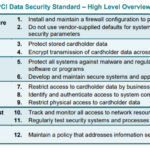In the ever-evolving technological landscape, securing customer data and ensuring compliance with regulatory standards is more crucial than ever before. This article aims to comprehensively guide you through the financial implications of achieving compliance with the Payment Card Industry Data Security Standard (PCI-DSS). Exuding a wealth of knowledge, it elucidates the underlying direct and indirect costs and the potential financial benefits that your business stands to gain from this globally recognized security standard.

Understanding PCI-DSS
Before we delve into the costs related to becoming PCI-DSS compliant, it is crucial to understand what exactly PCI-DSS is.
Definition of PCI-DSS
PCI-DSS stands for Payment Card Industry Data Security Standard. It’s a standard that provides guidelines for businesses for safe and secure handling of cardholder information in a digital environment. In essence, it ensures digital safety for all businesses that store, process, or transmit credit card data.
Importance of PCI-DSS compliance
Compliance with PCI-DSS is not optional; instead, it is a mandatory requirement for businesses that deal with cardholder data. This importance emanates from its central role in minimizing the risk of data breaches, fraud, theft, and other cyber-attacks that can harm both businesses and consumers. Essentially, complying with PCI-DSS protects your business from the adverse financial and legal consequences of data breaches.
Determining Where Your Business Falls in the PCI-DSS Compliance Levels
Understanding the specifics of your PCI-DSS compliance level is the first step toward managing compliance costs.
Different levels of PCI-DSS compliance
There are four PCI-DSS compliance levels, determined by the volume of transactions a business processes annually. Level 1 includes businesses processing over six million transactions, level 2 comprises those with one to six million, level 3 includes companies handling 20,000 to 1 million, and level 4 involves those processing fewer than 20,000 transactions.
How businesses are classified into different compliance levels
Classification into these levels mainly depends on the number of transactions processed. This classification is critical because it determines the level of auditing required to achieve compliance.
How compliance level affects related costs
The costs associated in achieving compliance rises with its level. Higher levels require more robust and complex security systems and audits, translating to more significant investment.
Direct Costs of Achieving PCI-DSS Compliance
Attaining PCI-DSS compliance involves several direct costs.
Expenses on required hardware and software
This includes the cost of implementing secure network systems, developing secure systems and applications, encrypting transmission of cardholder data, and regular updates and patch installations.
Cost of conducting a PCI-DSS compliance audit
Depending on the compliance level, a business may need to conduct internal audits or hire an external Qualified Security Assessor (QSA). These audits are necessary for businesses to ensure that all security measures are being adhered to and are effective.
Recurring fees like annual validation and reporting
Annual validation costs are required to maintain your PCI compliance status, while reporting costs entail regularly documenting your compliance activities.
Indirect Costs of Becoming PCI-DSS Compliant
Apart from direct costs, businesses also incur indirect expenses when achieving PCI-DSS compliance.
Human resources and time related costs
These encompass hiring additional staff or outsourcing specialists to handle compliance activities. Time is another essential factor as achieving and maintaining compliance is a long-term process needing regular attention and efforts.
Costs related to potential business disruptions during implementation
Implementing data security measures may interrupt regular business operations, which may result in potential revenue losses.
Costs associated with long term maintenance and training
Long term costs include maintaining and improving security measures and providing regular training to employees to ensure they understand and follow security practices.
Potential Penalties and Fines for Non-Compliance
Failure to adhere to PCI-DSS standards can lead to hefty consequences for businesses.
Monetary fines
Financial penalties can range from $5,000 to $500,000, depending on the severity and aftereffects of non-compliance.
Reputation risk and potential loss of business
Data breaches can harm a business’s reputation, potentially resulting in loss of customer trust and business.
Possible legal sanctions
In specific cases, non-compliance could also result in legal sanctions, including lawsuits, if data breaches result in significant harm to customers.
Reducing PCI-DSS Compliance Costs
While achieving compliance can be expensive, you can take measures to keep these costs under control.
Choosing appropriate solutions to match business needs
This pertains to selecting the right hardware, software, and third-party services that align with your business requirements. Making the right choices here can avoid unnecessary expenses.
Implementing streamlined processes
By simplifying and streamlining your cardholder data environment, you can reduce the scope of your PCI-DSS audit and lower its related costs.
Training staff to ensure ongoing compliance
Well-trained staff can better understand and comply with security requirements, reducing the need for further investment down the line.
Outsourcing PCI-DSS Compliance
Many businesses opt to outsource their compliance operations due to the complexities involved in achieving compliance.
Pros and cons of outsourcing
Outsourcing can save businesses from the hassle of managing compliance in-house and potentially reduce costs and risks. However, this can mean less control over the process and dependence on third-party providers.
Cost comparison between in-house and outsourced compliance
Although outsourcing might seem expensive initially, long-term calculations often reveal that in-house operations, when accounting for all the direct and indirect costs, can be costlier.
Best practices when choosing a PCI-DSS compliance vendor
Choosing the right vendor involves assessing their expertise, capabilities, reliability, and the cost they offer.
Case Studies of PCI-DSS Compliance Cost
These case studies exemplify the disparity in compliance costs depending on the business’s size. Small, medium, and large businesses can have significantly different experiences with compliance costs.
Small business compliance cost study
Smaller businesses may have relatively lower compliance costs due to lower transaction volumes. However, they must also weigh these costs versus the potential fees for non-compliance which could be devastating due to limited resources.
Medium business compliance cost study
Medium-sized businesses may incur medium to high compliance costs, as they handle more transactions than small businesses but may not have as many resources as larger corporations.
Large business compliance cost study
Large businesses generally face the highest compliance costs due to the large volume of transactions and higher audit requirements. However, they often have the resources to invest in comprehensive compliance measures.
Cost-Benefit Analysis of PCI-DSS Compliance
While the costs associated with PCI-DSS compliance can be on the higher side, it’s important to weigh these against the potential costs of non-compliance and the benefits of being compliant.
Understanding the financial implications
The direct and indirect costs can seem overwhelming, but they protect the business from greater financial risks like penalties, fees, and loss of business.
Assessing the intangible benefits
Intangible benefits like enhanced trust from customers, protection of your brand’s reputation, and increased competitive advantage can outweigh the financial investment.
Determining if PCI-DSS compliance is a good investment for your business
It’s crucial to analyze whether the benefits of being PCI-DSS compliant outweigh the cost based on your specific business model and risk profile.
Future Trends in PCI-DSS Compliance Costs
As digital payment solutions continue to evolve, businesses can expect changes in the cost of achieving and maintaining PCI-DSS compliance.
Predicted changes in compliance cost elements
As technology advances, the direct costs related to hardware and software may decrease. However, the complexity of cyber threats might increase, potentially inflating the cost of audit and compliance maintenance.
How emerging technologies may impact costs
Emerging technologies like AI and machine learning could streamline compliance procedures and bring down the costs.
Strategies to anticipate and control future cost increases
Developing a long-term compliance strategy, investing in scalable solutions, and continuous training can go a long way in controlling future cost increases.










